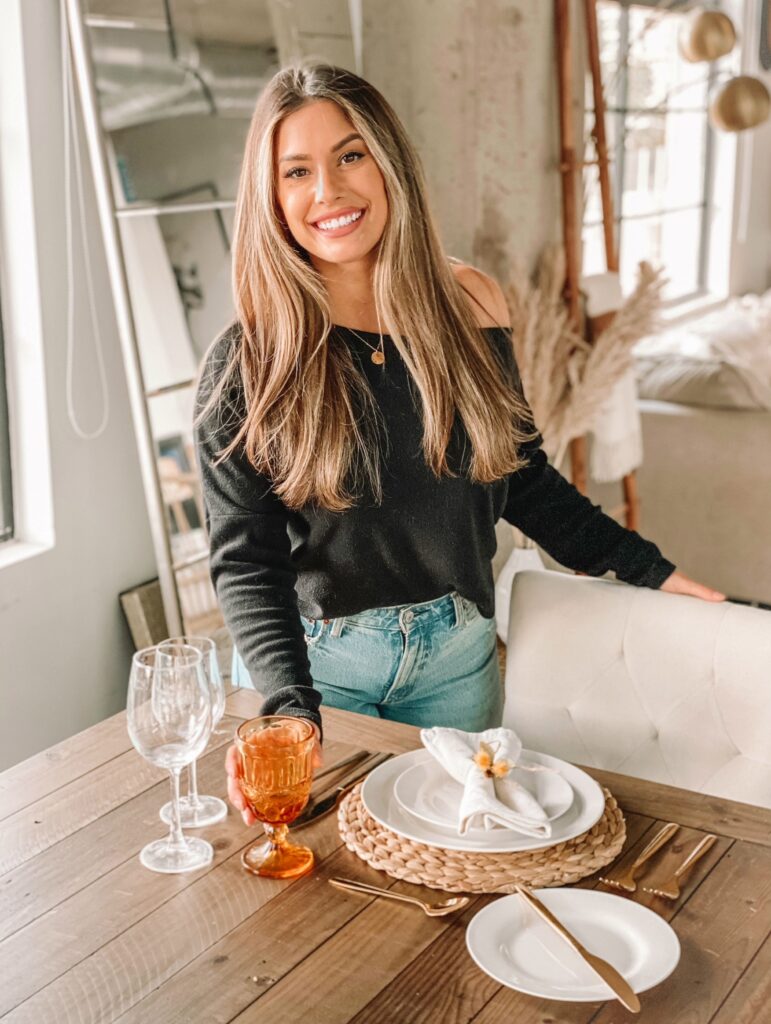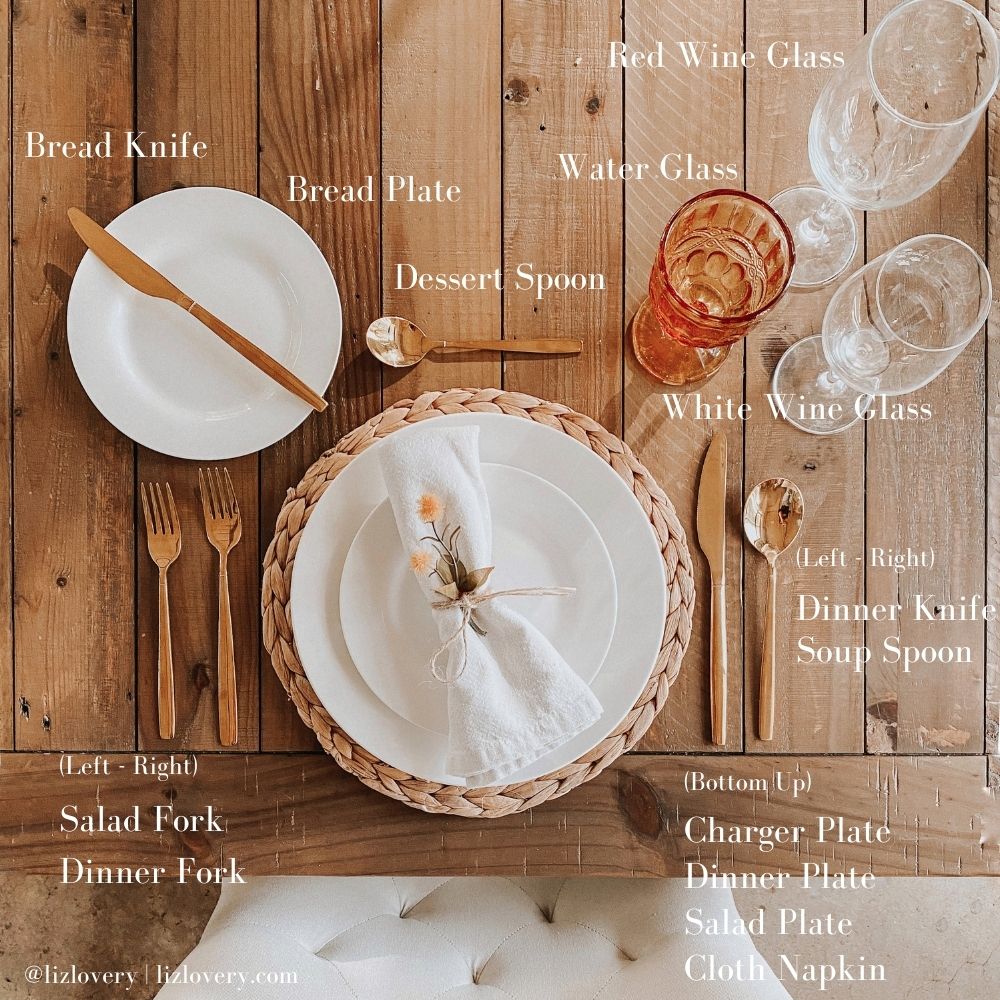Learning how to set a table for a dinner party or special occasion is something I think everyone should know how to do, especially if you’re a regular host or hostess! It’s a simple way to elevate your tablescape and leave your guests feeling like they just dined at a 5-star restaurant. And you don’t need a 10-piece dinner set either!



I remember the first time I really noticed a well-set dinner table. I was 12 years old and I was watching the movie The Princess Diaries with Anne Hathaway and Julie Andrews—specifically the scene where Mia was taking etiquette classes during her “princess training”. I had always been fascinated with the lifestyle and traditions of high society and the elite, but I came from an average, middle-class family in the suburbs and was accustomed to using plastic water cups and a paper napkins and our dinner table. Nothing fancy, just the basics.
I always assumed that sort of thing was reserved for rich people, but the fact of the matter is that having an impressive dinner table isn’t unattainable at all. It simply comes down to understanding how to set a table properly. So, I’m going to share with you a simple table setting layout that you can use for any occasion.
How To Set A Table
This is a simple example of how a table setting can be displayed and a few notes on what to keep in mind.



- Charger Plate—A charger plate is a large, oftentimes decorative, plate that sits beneath the dinner plate. The purpose of a charger plate is to catch anything that might spill off of the dinner plate during the meal. The charger plate can also be substituted for a placemat.
- Dinner Plate—The dinner plate should be self explanatory, but is the primary plate your main course will be served on. The dinner plate sits on top of the charger plate.
- Salad Plate—The salad plate sits on top of the dinner plate and is used for serving the salad. You may also use the salad plate as an appetizer plate if you have a smaller dining set.
- Soup Bowl (not pictured)—If you’re serving soup, you should place your soup bowl on top of the salad plate.
- Cloth Napkin—For any formal dinner, cloth or linen napkins should be used over paper napkins. But, of course, if you don’t have cloth napkins, paper napkins will do just fine. There are a few ways to display them on your place setting but one way I prefer is to use a napkin ring and set the napkin on top of the salad plate.
- Bread Plate—The bread plate is typically a bit smaller than the salad plate and sits at the top left of the charger plate. I don’t have separate bread plates so I use a salad plate.
- Bread Knife—The bread knife sits on top of the bread plate and a 45 degree angle with the blade facing away from the plate. A separate knife for the bread is typically given so that any butter or spread doesn’t mix with the food in the main course.
- Salad Fork—The salad fork is typically the smaller of the two forks and should be placed to the left of the dinner fork and on the left of the dinner plate. If you’re ever confused just remember that the flatware is arranged for use from the outside-in. Meaning, the flatware that sits on the outside will be the one you use first in the order of how dinner is served. Salad is served before the main course, therefore, the salad fork sits on the outside of the dinner fork.
- Dinner Fork—The dinner fork is the larger of the two forks and is used during the main course. It sits on the inside of the two forks on the left side of the dinner plate.
- Dinner Knife—The dinner knife sits on the right side of the dinner plate with the plate facing in.
- Soup Spoon—Similar to the salad fork, the soup spoon is typically used before the main course, therefore, should sit on the outside of the dinner knife on the right side of of the plate. The soup spoon is the larger of the two spoons if your flatware set comes with two (this is standard for most flatware sets).
- Dessert Spoon—The dessert spoon is the smaller of the two spoons and sits horizontally above the dinner plate with the mouth of the spoon facing left. Because this is served with dessert, which is the last course of the dinner, it’s set off to the side and out of the way of the other flatware.
- Water Glass—The water glass sits on the top right of the dinner plate. It’s closest to the plate as will likely be the beverage people will drink most throughout the meal to cleanse their palates before their next bite.
- Red Wine Glass—Red wine glasses are typically larger than white wine glasses. This should sit to the right, and slightly higher than the water glass.
- White Wine Glass—The white wine glass is the smaller of the two wine glasses and sits just below the red wine glass and to the right of the water glass. It’s common to provide both a red and white wine glass for your guests based on their preference and also what type of food is being served.
Proper Serving Order & Your Table Setting
When it comes to creating an elegant table setting, it’s important to remember the dining experience as a whole and the typical order in which a meal is served. Here’s a breakdown of a typical 4-course dinner and how your table setting comes into play.
- Appetizers—Since appetizers are the first thing on the menu, having a smaller plate (like a bread plate) readily available is important. If you don’t have a large dinner set, your guests can use the salad plate for their appetizer. The bread plate may also be used during the main course.
- Soup / Salad—Next up is the soup/salad course. The salad plate will sit on top of the dinner plate since they will be using this plate first. This is also why the soup spoon and salad fork sit on the outside of the dinner knife and dinner fork. If you’re ever unsure, just start from the outside and work your way in.
- Main Course—For the main course you will use the dinner plate, the dinner fork, and the dinner knife.
- Dessert—Because dinner is served last, the dessert spoon is set off to the side and a fresh plate is used.
